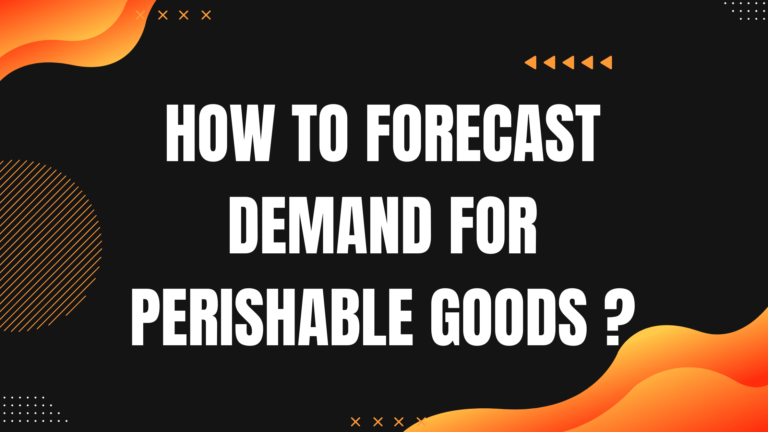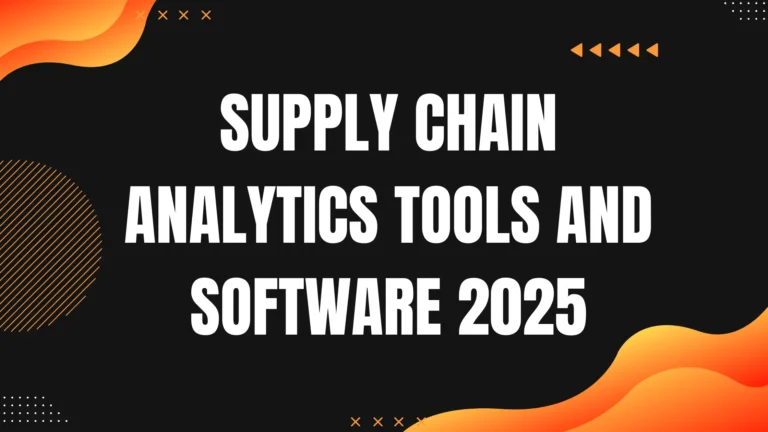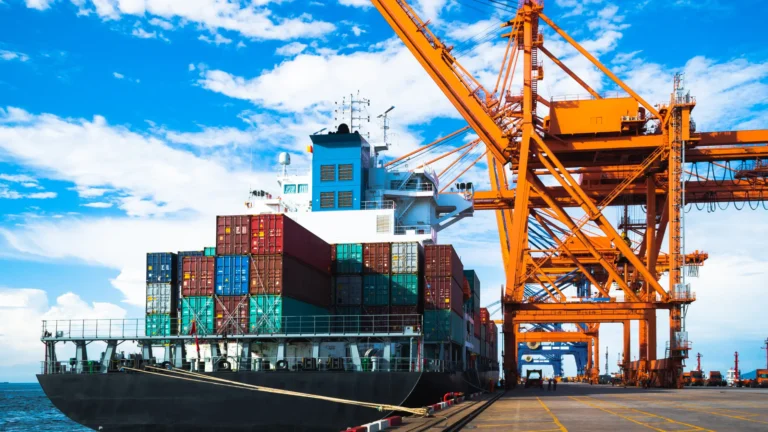In recent years, the way we shop and receive products has evolved dramatically. One of the most significant changes is the rise of quick commerce, a model that promises ultra-fast deliveries, often within minutes, powered by an optimized quick commerce supply chain. But what is quick commerce, and how does it work? This guide will take you through the fundamentals of quick commerce, explain the mechanics behind it, and explore why it’s becoming an essential part of modern retail.
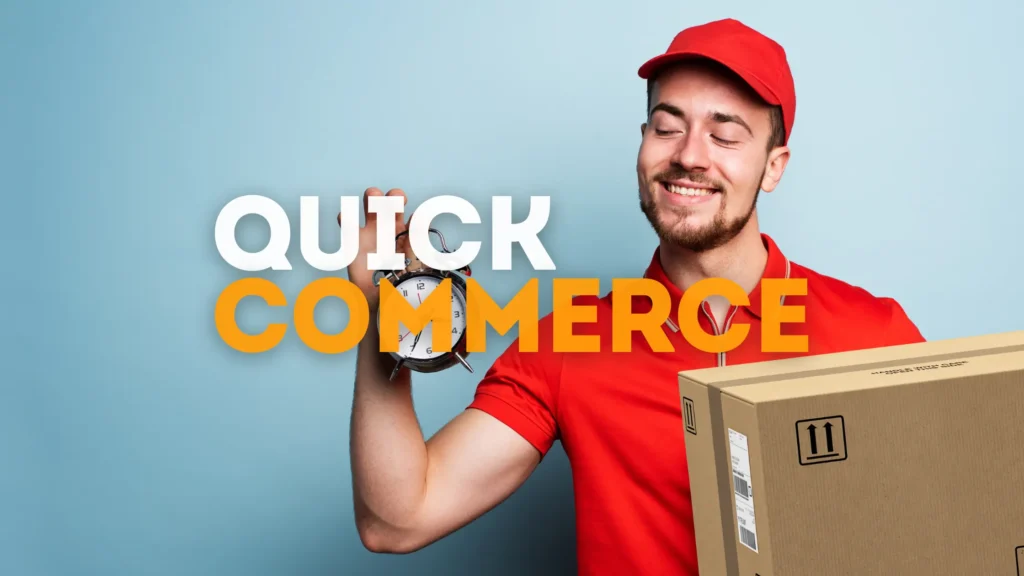
Whether you’re a business owner, a consumer, or just curious about this fast-growing trend, this post will provide everything you need to know about the world of quick commerce.
What is Quick Commerce?
Quick commerce, also known as q-commerce, is a delivery model focused on providing rapid delivery of goods—often within 10 to 60 minutes. Unlike traditional e-commerce, which may take a day or more to fulfill an order, quick commerce prioritizes speed and convenience, delivering products directly to consumers as quickly as possible.
Quick commerce typically focuses on everyday essentials such as groceries, personal care items, and pharmaceuticals. By leveraging localized fulfillment centers and real-time inventory management, q-commerce ensures that customers receive their orders with unprecedented speed.
Key Features of Quick Commerce:
- Speed: Orders are fulfilled in under 60 minutes, often within 10-30 minutes.
- Limited Product Range: Focuses on high-demand, frequently purchased items.
- Convenience: Enables consumers to make quick, last-minute purchases with minimal waiting time.
How Does Quick Commerce Work?
Quick commerce, or q-commerce, has revolutionized how we shop by offering ultra-fast delivery services, often within 10 to 30 minutes. But how does quick commerce work, and what makes it so efficient? Let’s break it down step by step.
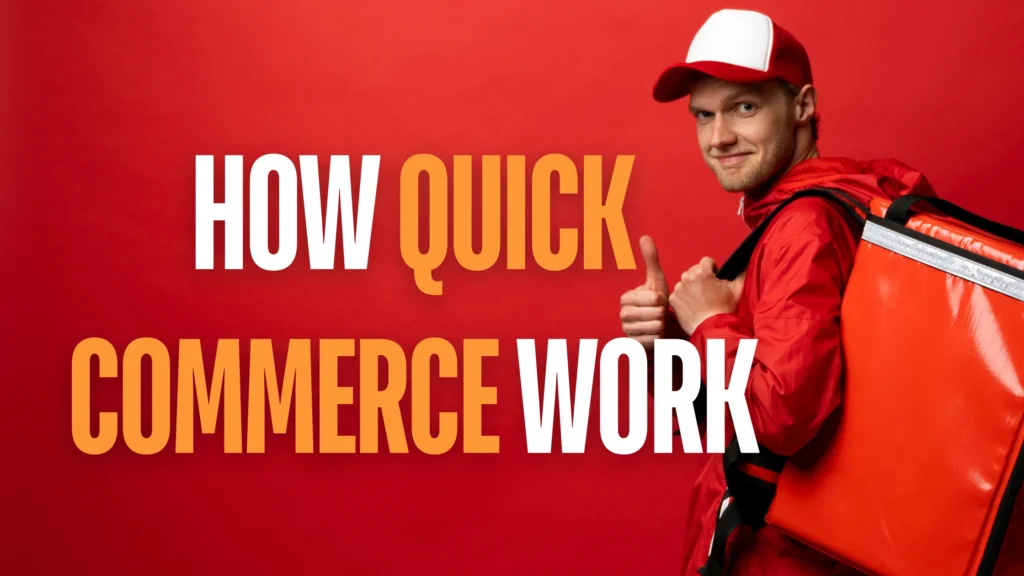
1. Real-Time Inventory Management
Quick commerce platforms rely on real-time inventory tracking to ensure that the products available in nearby fulfillment centers are accurately reflected in the online catalog. As soon as a customer places an order, the platform checks which nearby facility has the item in stock.
2. Dark Stores and Micro-Fulfillment Centers
At the heart of how quick commerce works are dark stores, which are small, local fulfillment centers. Unlike traditional warehouses, these stores are not open to the public. Instead, they focus solely on storing high-demand products, like groceries and household essentials, to ensure orders are ready for immediate dispatch. Because they are strategically located close to urban areas, dark stores allow companies to fulfill orders quickly and minimize delivery times.
3. Last-Mile Delivery Optimization
Once an order is ready, it’s handed over to a delivery driver. The success of q-commerce heavily depends on optimizing last-mile delivery—the final leg of the journey from the fulfillment center to the customer’s door. This step is optimized using route-planning algorithms and real-time tracking to ensure the fastest delivery possible.
4. Technology and Automation
Quick commerce companies leverage advanced technologies and prioritize automation, which is key to their fast and efficient operations.When a customer places an order through an app, automated systems within the dark store process the order. This includes inventory management, where stock levels are constantly updated in real time to avoid delays.
Moreover, companies use route optimization algorithms, which determine the fastest possible path for delivery riders. This technology ensures that goods are delivered promptly, sometimes within 10 minutes of the order being placed.
For a more detailed comparison of how quick commerce differs from traditional e-commerce, check out our post on quick commerce vs e-commerce
Key Players in the Q-commerce Industry
Quick commerce has seen rapid growth, particularly in urban areas where speed and convenience are highly valued. Several companies have emerged as leaders in the q-commerce space:
1. Swiggy Instamart – India’s Full-Stack Q-Commerce Platform
Backed by Swiggy’s robust delivery network, Instamart delivers groceries and daily essentials in 10 to 30 minutes across major Indian cities. Unlike pure-play q-commerce startups, Instamart leverages Swiggy’s existing fleet and deep market presence to scale rapidly. It offers a wide assortment—from fresh produce to household items—operating through a mix of dark stores and partner fulfillment centers.
💡 Fun Fact: Instamart has expanded into smaller cities and Tier-2 towns, making Swiggy one of the few players addressing semi-urban Q-commerce demand.
2. Zepto – Disrupting India with Sub-10 Minute Delivery
Zepto has quickly carved a niche in India’s metro cities, promising grocery delivery within 10 minutes. The company relies on a dense network of dark stores, demand forecasting, and SKU standardization to execute on-time deliveries with minimal errors.
3. Blinkit (formerly Grofers) – Fast Essentials, Backed by Zomato
Blinkit pivoted into Q-commerce in 2021 and now operates in over 20 Indian cities. With delivery promises of 10–20 minutes, it focuses on daily essentials, FMCG products, and even stationery and electronics. Blinkit’s acquisition by Zomato provides added operational and financial backing.
4. Gorillas – European Giant in Hyperlocal Fulfillment
Operating in cities like Berlin, Amsterdam, and London, Gorillas offers ultra-fast grocery delivery within 10 minutes. It runs its own warehouses, maintaining tight control over inventory, freshness, and assortment. Despite market challenges, it remains a recognized brand in European Q-commerce.
5. Getir – Turkey’s Global Q-Commerce Powerhouse
Getir started in Turkey and quickly expanded to Europe and the U.S. Its model focuses on convenience and variety, with a delivery time promise of under 15 minutes. Getir has also acquired competitors like Weezy (UK) and Gorillas (Germany) to consolidate its position in mature markets.
These companies have built their success by focusing on hyper-local logistics, leveraging technology to deliver products faster than traditional e-commerce platforms.
Why is Q-commerce Growing So Fast?
Several factors are contributing to the explosive growth of quick commerce, making it one of the fastest-growing sectors in the retail industry:
1. Consumer Demand for Speed and Convenience
In today’s fast-paced world, consumers increasingly prioritize convenience. q-commerce delivers on this demand by providing essential goods almost instantly, eliminating the need to wait for delivery windows that last hours or days.
2. Urbanization and Densely Populated Areas
q-commerce thrives in cities and urban areas where delivery points are close to fulfillment centers. As more people move to cities, the need for ultra-fast delivery of everyday items has grown.
3. Technological Advancements
Technology is at the heart of quick commerce’s success. The integration of AI, real-time data analytics, and mobile platforms enables companies to optimize their operations and meet the expectations of customers demanding faster services.
4. Mobile-First Shopping
The rise of mobile commerce has made it easier for consumers to shop on the go. Quick commerce platforms are designed to cater to this demand, offering mobile apps that allow users to order products and receive them almost immediately.
Important Metrics of Quick Commerce (Q-commerce)
Measuring these important metrics is crucial for any quick commerce business aiming to optimize its operations and stay competitive.
Delivery Time (Speed of Delivery)
Delivery time refers to the average time it takes for an order to reach the customer after it has been placed. q-commerce thrives on speed, with most companies aiming to deliver orders within 30 to 60 minutes. Reducing delivery time is crucial for maintaining customer satisfaction and staying competitive in this fast-paced market.
To optimize delivery time, companies focus on last-mile delivery efficiency, use micro-fulfillment centers, and implement advanced route-planning technology.
Order Fulfillment Rate
Order fulfillment rate measures the percentage of orders that are successfully completed and delivered on time. A high fulfillment rate reflects the efficiency of a company’s operations and its ability to meet customer expectations.
Improving fulfillment rates involves optimizing inventory management, ensuring real-time tracking, and minimizing stockouts.
Average Order Value (AOV)
The average order value (AOV) represents the average amount spent by a customer in a single transaction. For quick commerce businesses, increasing AOV is critical because delivery costs are often fixed, regardless of the order size. A higher AOV can significantly boost profitability.
Businesses can raise AOV by offering bundle deals, free delivery for higher-value orders, or product recommendations during checkout.
Customer Retention Rate
Customer retention rate indicates the percentage of customers who return to make additional purchases. In q-commerce, retaining customers is particularly important because acquiring new customers can be costly. A high retention rate signals strong brand loyalty and satisfaction.
To improve retention, businesses can introduce subscription models, loyalty programs, or discounts on future orders. Ensuring consistent delivery times and positive experiences will also help build trust and loyalty.
Order Frequency (Repeat Purchase Rate)
Order frequency, or the repeat purchase rate, tracks how often customers place orders within a specific time frame. A high order frequency indicates that customers are satisfied with the service and are more likely to return for future purchases.
Encouraging repeat purchases can be achieved by offering personalized promotions, sending push notifications through mobile apps, or simplifying the reordering process.
Customer Satisfaction (CSAT) and Net Promoter Score (NPS)
Customer satisfaction (CSAT) measures how happy customers are with their overall experience, while Net Promoter Score (NPS) gauges how likely customers are to recommend the service to others. Both metrics are vital indicators of the overall quality of service provided by a q-commerce platform.
Businesses can improve CSAT and NPS by ensuring timely deliveries, providing excellent customer support, and gathering feedback to address any issues that may arise.
Cost Per Delivery (Delivery Efficiency)
Cost per delivery represents the average cost incurred for each order delivered, which includes fuel, driver wages, and operational expenses. Controlling the cost per delivery is essential for quick commerce businesses, as high operational costs can eat into profits.
To lower delivery costs, companies can use AI-powered route optimization, group deliveries to maximize efficiency, and explore autonomous vehicle solutions like drones.
Inventory Turnover Rate
The inventory turnover rate indicates how frequently stock is sold and replaced over a specific period. In q-commerce, maintaining a high inventory turnover rate is essential because it ensures that high-demand products are always available without overstocking items that move slowly.
Using real-time demand forecasting, precise inventory tracking, and stocking the most frequently purchased products can help increase turnover rates.
Stockout Rate
Stockout rate refers to the percentage of times a product is out of stock when customers attempt to order it. Frequent stockouts frustrate customers, lead to lost sales, and damage a company’s reputation. In the quick commerce industry, avoiding stockouts is especially important since customers expect fast and reliable service.
Businesses can reduce stockout rates by improving demand forecasting, coordinating with suppliers, and using automatic replenishment systems to keep popular items in stock.
Profit Margin Per Delivery
Profit margin per delivery measures the profit a company makes from each delivery after accounting for product costs, delivery expenses, and operational overhead. Since margins in quick commerce can be slim, tracking this metric is critical for maintaining profitability.
Improving profit margins involves increasing average order values, reducing delivery costs through efficient logistics, and focusing on high-margin products.
Order Accuracy
Order accuracy refers to how often orders are delivered correctly, with the right items and no missing products. Quick commerce relies on precise order fulfillment to meet customer expectations, and any errors can lead to dissatisfaction and returns.
To improve accuracy, companies can implement barcode scanning, automated picking systems, and strict quality control processes at fulfillment centers.
Challenges Faced by Quick Commerce
Despite its benefits, quick commerce comes with its own set of challenges. Here are a few of the most significant hurdles that companies in this space face:
1. High Operational Costs
Maintaining the infrastructure for quick commerce—such as dark stores, delivery fleets, and real-time inventory systems—can be costly. Balancing speed with profitability remains a major challenge.
2. Sustainability Issues
The emphasis on fast deliveries often results in higher carbon emissions and excessive packaging waste. Companies are under increasing pressure to develop more sustainable delivery practices while maintaining their speed.
3. Inventory Management
Ensuring that the right products are in the right place at the right time is a major logistical challenge. Quick commerce requires extremely precise inventory management to avoid stockouts and delays, which can frustrate customers.
The Future of Quick Commerce
The future of quick commerce looks bright, with continued growth projected across urban markets. Here’s what we can expect in the coming years:
- Expansion to New Cities and Regions: As the demand for quick commerce grows, companies will expand their operations beyond urban centers into smaller cities and towns.
- Increased Use of Automation: More companies are likely to invest in automation, including autonomous delivery vehicles, drones, and robot-powered warehouses, to streamline their operations and cut costs.
- Sustainability Innovations: Expect to see a stronger focus on sustainability, with efforts to reduce the environmental impact of last-mile delivery and packaging.
Quick commerce is reshaping the retail industry by offering consumers a level of convenience that was previously unimaginable. As more companies enter the space and competition heats up, the focus will shift to improving efficiency and sustainability while maintaining the speed that customers have come to expect.
Is quick commerce sustainable?
Quick commerce is currently unsustainable due to high environmental impact, operational costs, and social challenges, but can improve with eco-friendly practices, efficient models, and fair labor policies.
Quick commerce faces several sustainability challenges across environmental, economic, and social fronts. While it offers undeniable convenience, the current model is often resource-intensive and dependent on external investment. For it to be sustainable in the long term, companies will need to address these following issues
1. Environmental Sustainability
Quick commerce typically relies on a fleet of delivery vehicles, ranging from bicycles to motorbikes and cars, to meet tight delivery deadlines. This can lead to several environmental challenges:
- Carbon Footprint: The rapid and frequent delivery cycles often result in inefficient routing and frequent trips, leading to higher fuel consumption and increased emissions.
- Packaging Waste: Since many quick commerce platforms focus on small, fast deliveries, items are frequently over-packaged in order to protect them during transport. This leads to an increase in single-use plastics and other materials, contributing to waste.
- Energy Consumption: Warehouses, especially dark stores (micro-fulfillment centers dedicated solely to online orders), may require additional energy for operations, storage, and refrigeration, increasing the overall carbon footprint.
Potential Solutions for Environmental Impact:
- Electric Delivery Vehicles: Adoption of electric scooters or bikes could significantly reduce the carbon footprint.
- Sustainable Packaging: Using eco-friendly packaging materials can help curb waste, though this is often costlier.
- Efficient Route Planning: Advanced algorithms can be used to optimize delivery routes, minimizing the distance traveled and, thus, emissions.
2. Economic Sustainability
From a business perspective, the quick commerce model faces numerous economic challenges:
- High Operational Costs: Quick commerce requires an extensive delivery network, including warehouses, inventory management, and a large fleet of delivery personnel. The infrastructure and labor costs to maintain fast deliveries are high.
- Low Margins: Many products, especially groceries and small consumer goods, have slim profit margins. When combined with free or subsidized delivery, this creates a strain on profitability.
- Customer Retention vs. Cost: Companies often offer discounts, free delivery, or other incentives to attract customers. However, these customer acquisition costs may be unsustainable long-term without a high retention rate.
- Investment Dependency: Many quick commerce startups rely heavily on venture capital funding to maintain operations, as they struggle to become profitable. Without a clear path to profitability, this model may not be viable in the long run if investor sentiment changes.
Potential Solutions for Economic Viability:
- Automation in Fulfillment Centers: Investing in automation and AI in warehouses can reduce labor costs and improve efficiency.
- Subscription Models: Some companies offer subscription services with a monthly or yearly fee, providing unlimited or discounted deliveries. This can help offset operational costs.
- Expanding Product Offerings: Offering higher-margin products or premium services could help improve profitability.
- Partnerships: Collaborating with brands, local stores, or suppliers to create exclusive offerings could drive higher margins or reduce procurement costs.
3. Social Sustainability
The impact of quick commerce on labor and society is significant, particularly in terms of the gig economy:
- Delivery Rider Conditions: Delivery workers are often classified as gig workers, meaning they don’t have the same protections, benefits, or job security as traditional employees. The pressure to make quick deliveries can also lead to unsafe working conditions, such as speeding or overworking.
- Job Creation vs. Stability: While quick commerce creates many jobs in the delivery and logistics sectors, these are often low-paying and lack long-term stability. The churn in this workforce can make it difficult to build a sustainable workforce model.
- Impact on Local Businesses: Quick commerce often competes with local stores, which may struggle to match the speed and convenience of online deliveries. This can contribute to the decline of small, local retailers.
Potential Solutions for Social Impact:
- Better Pay and Benefits for Gig Workers: Offering fair wages, benefits, and job security could improve the sustainability of the workforce.
- Balancing Automation and Job Creation: While automation may help reduce costs, businesses should ensure they are still providing meaningful employment opportunities.
- Community Integration: Partnering with local businesses to fulfill orders can create a more symbiotic relationship with the community.
FAQ
Conclusion
Quick commerce is not just a trend—it’s a revolutionary way of meeting consumer needs in real time. By blending technology, logistics, and consumer demand for speed, quick commerce is rapidly transforming how we shop for everyday essentials. From local dark stores to real-time delivery tracking, this model is setting the pace for the future of retail.
If you’re curious about how quick commerce compares to other delivery models, explore our related posts on quick commerce vs e-commerce or quick commerce vs hyperlocal delivery

